|

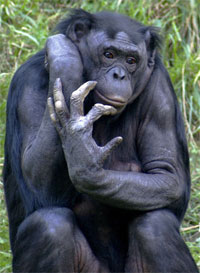 Looks kind of humanlike: The bonobo is more gracile than the Common chimpanzee. Its head is smaller than that of the Common chimpanzee but has a higher forehead. It has a black face with pink lips, small ears, wide nostrils, and long hair on its head. Females have slightly prominent breasts in contrast to the flat breasts of other female apes, though not as prominent as those of humans. The bonobo also have slim upper bodies, narrow shoulders, thin necks, and long legs compared to the Common chimpanzee. These characteristics, and their posture, give bonobos a more human-like appearance than that of Common chimpanzees. Bonobos can easily walk upright on two legs, and can look uncannily human while doing so. They also have head hair that parts down the middle! Looks kind of humanlike: The bonobo is more gracile than the Common chimpanzee. Its head is smaller than that of the Common chimpanzee but has a higher forehead. It has a black face with pink lips, small ears, wide nostrils, and long hair on its head. Females have slightly prominent breasts in contrast to the flat breasts of other female apes, though not as prominent as those of humans. The bonobo also have slim upper bodies, narrow shoulders, thin necks, and long legs compared to the Common chimpanzee. These characteristics, and their posture, give bonobos a more human-like appearance than that of Common chimpanzees. Bonobos can easily walk upright on two legs, and can look uncannily human while doing so. They also have head hair that parts down the middle!
Not so "animal" like: Professor Frans de Waal, one of the world's leading primatologists, avers that the Bonobo is often capable of altruism, compassion, empathy, kindness, patience and sensitivity.
Bonobo in the mirror : Bonobos passed the mirror-recognition test for self-awareness in 1994. They communicate through primarily vocal means, although the meanings of their vocalizations are not currently known; however, we do understand their facial expressions and some of their natural hand gestures, such as their invitation to play. Two Bonobos, Kanzi and Panbanisha have been taught a vocabulary of about 400 words which they can type using a special keyboard of lexigrams (geometric symbols), and can respond to spoken sentences. Some, such as bioethicist Peter Singer, argue that these results qualify them for the "rights to survival and life" rights that humans theoretically accord to all persons.

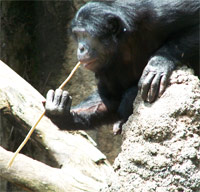 Our most intelligent cousins: Other than humans, many scientists consider bonobos the most intelligent of all primates. This could be because genetically they are considered our closest living relatives. They have many similar behaviors to humans - they teach their young social skills, they cooperate and work together for the benefit of the whole group, and they use tools to get food. Our most intelligent cousins: Other than humans, many scientists consider bonobos the most intelligent of all primates. This could be because genetically they are considered our closest living relatives. They have many similar behaviors to humans - they teach their young social skills, they cooperate and work together for the benefit of the whole group, and they use tools to get food.
Talking with bonobos: Scientists have taught a few bonobos communication skills to converse with humans, using symbols that represent words on a board. These bonobos can understand spoken words and reply to questions using the board (pointing to symbols to reply or ask for things)!
Looking like humans: In addition to walking upright which makes them look remarkably human-like, they also seem very human in other behaviors - one being that they laugh when playing together or tickling each other!
Make love not war: Sexual intercourse plays a major role in bonobo society, being used as a greeting, a means of conflict resolution and post-conflict reconciliation, and as favors traded by the females in exchange for food. This happens within the immediate family as well as outside of it, and often involves adults and children. Bonobos do not form permanent relationships with individual partners. They also do not seem to discriminate in their sexual behavior by gender or age, with the possible exception of sexual intercourse between mothers and their adult sons; some observers believe these pairings are taboo. When Bonobos come upon a new food source or feeding ground, the increased excitement will usually lead to communal sexual activity, assumedly decreasing tension and allowing for peaceful feeding.
Lots of lovin, not so many babies: Bonobo reproductive rates are not any higher than that of the Common chimpanzee. Female bonobos carry and nurse their young for around five years and can give birth every five to six years. Compared to Common chimpanzees, bonobo females resume the genital swelling cycle much sooner after giving birth, allowing them to rejoin the sexual activities of their society. Also, bonobo females who are either sterile or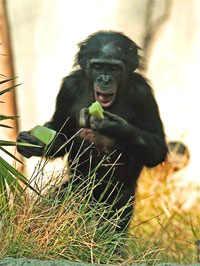 too young to reproduce engage in sexual activity. too young to reproduce engage in sexual activity.
Ruling females: Females are much smaller than males but can be considered to have a higher social status. Aggressive encounters between males and females are rare, and males are tolerant of infants and juveniles. The male's status reflects the status of his mother, and the son-mother bond often stays strong and continues throughout life. While social hierarchies do exist, rank does not play as prominent a role as it does in other primate societies. This may be because at any one time certain females of a group will be in estrus, and since food is relatively ample.
Fusion-fission: Bonobos live in a fusion-fission pattern: a tribe of about a hundred will split into small groups during the day while looking for food, and then come back together to sleep. Unlike Common chimpanzees, who have been known to hunt monkeys, bonobos are primarily herbivores, although they do eat insects and have been observed occasionally catching small mammals such as squirrels. Their primary food source is fruit.

Upright gait, prominent sexual activity: The Bonobo was discovered in 1928, by American anatomist Harold Coolidge, represented by a skull in the Tervuren museum in Belgium that was thought to have belonged to a juvenile chimpanzee, though credit for the discovery went to the German Ernst Schwarz, who published the findings in 1929. The species is distinguished by an upright gait, a matriarchal and egalitarian culture, and the prominent role of sexual activity in their society.
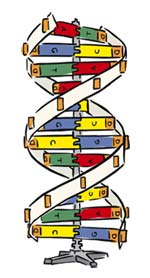 Name calling: One theory on the origin of the name "Bonobo" is that it is a misspelling of the name of the town of Bolobo on the Congo river. A more likely explanation is that it comes from the name for "Ancestor" in an ancient Bantu language. Name calling: One theory on the origin of the name "Bonobo" is that it is a misspelling of the name of the town of Bolobo on the Congo river. A more likely explanation is that it comes from the name for "Ancestor" in an ancient Bantu language.
98% similar to human DNA: As noted above, the scientific name for the Bonobo is Pan paniscus. Since the Bonobo DNA is more than 98% equal to that of Homo sapiens, some scientists maintain that they (and the Common Chimpanzee) should be reclassified as members of the genus Homo -- Homo paniscus, Homo sylvestris, or Homo arboreus. An alternate philosophy suggests that the term Homo sapiens is actually the misnomer, and that humanity should be reclassified as Pan sapiens.
Possible Advertisement
 Very few left, in very few places: Around 10,000 bonobos are found only in the humid forests south of the Congo River, in the Democratic Republic of Congo of central Africa. They are an endangered species, due to both habitat loss and hunting for bushmeat, the latter activity having waxed dramatically during the current civil war due to the presence of heavily armed militias even in remote "protected" areas such as Very few left, in very few places: Around 10,000 bonobos are found only in the humid forests south of the Congo River, in the Democratic Republic of Congo of central Africa. They are an endangered species, due to both habitat loss and hunting for bushmeat, the latter activity having waxed dramatically during the current civil war due to the presence of heavily armed militias even in remote "protected" areas such as 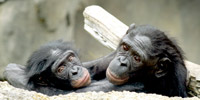 Salonga National Park. Today, at most several thousand bonobos remain. This is part of a more general trend of ape extinction. Salonga National Park. Today, at most several thousand bonobos remain. This is part of a more general trend of ape extinction.
Save the bonobos! The genetic closeness of Bonobos, their relative rarity, and their self-awareness compel a moral and scientific imperative to preserve them and protect them from both abuse and extinction. Currently Bonobos may still be hunted to extinction by humans who eat them.
Ways to help: Starting in about 2004, some concerned parties have addressed the crisis plight of these cousins of humanity on several science and ecological websites. Organizations like the WWF, the African Wildlife Foundation, and others are trying to focus attention on the extreme risk to the species. Some have suggested that a reserve be established in a less unstable part of Africa, or on an island in a place like Indonesia. Non-invasive medical research could be conducted on relocated free Bonobos with little risk or discomfort.
Gorillas | Chimpanzees | Humans | Orangutans | Gibbons | Primates| Apes| Monkeys| Prosimians
All text is available under the terms
of the GNU Free Documentation License
|